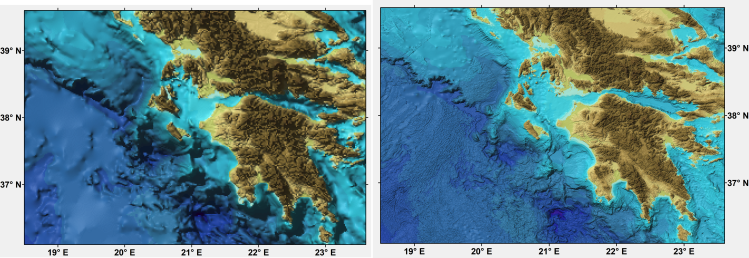GEBCO's first global bathymetric grid, the GEBCO One Minute Grid, was released in 2003. Since then a number of GEBCO grids have been published, with the latest release being available here.
Download compressed files containing the referenced historical GEBCO grids, in netCDF format, and accompanying metadata from the links below.
 Comparison of images showing the shape of the seafloor for part of the Ionian Sea region off Greece as generated from the GEBCO One Minute Grid (left) and the GEBCO_2019 Grid (right)
Comparison of images showing the shape of the seafloor for part of the Ionian Sea region off Greece as generated from the GEBCO One Minute Grid (left) and the GEBCO_2019 Grid (right)
| Grid name | Latest release year | Grid interval |
|---|---|---|
| GEBCO_2022 Grid | 2022 | 15 arc-seconds |
| GEBCO_2021 Grid | 2021 | 15 arc-seconds |
| GEBCO_2020 Grid | 2020 | 15 arc-seconds |
| GEBCO_2019 Grid | 2019 | 15 arc-seconds |
| GEBCO_2014 | 2015 | 30 arc-seconds |
| GEBCO One Minute Grid | 2008 | One arc-minute |
A global grid at 15 arc-second intervals. Originally published in June 2022. This is the fourth GEBCO grid developed through the Nippon Foundation-GEBCO Seabed 2030 Project.
The grid uses as a ‘base’ Version 2.4 of the SRTM15+ data set, augmented with the gridded bathymetric data sets developed by the four Seabed 2030 Regional Centers.
The data set is accompanied by a Type Identifier Grid (TID). This data set identifies the type of source data that a grid cell is based on.
Access documentation for the grid.
Access errata information for the GEBCO_2022 Grid
A global grid at 15 arc-second intervals. Originally published in July 2021. This is the third GEBCO grid developed through the Nippon Foundation-GEBCO Seabed 2030 Project.
The grid uses as a ‘base’ Version 2.2 of the SRTM15+ data set, augmented with the gridded bathymetric data sets developed by the four Seabed 2030 Regional Centers.
The data set is accompanied by a Type Identifier Grid (TID). This data set identifies the type of source data that a grid cell is based on.
Access documentation for the grid.
Access errata information for the GEBCO_2021 Grid
A global grid at 15 arc-second intervals. Originally published in May 2020. This is the second GEBCO grid developed through the Nippon Foundation-GEBCO Seabed 2030 Project.
The grid uses as a ‘base’ Version 2 of the SRTM15+ data set (Tozer et al, 2019), augmented with the gridded bathymetric data sets developed by the four Seabed 2030 Regional Centers.
The data set is accompanied by a Type Identifier Grid (TID). This data set identifies the type of source data that a grid cell is based on.
Access documentation for the grid.
Access errata information for the GEBCO_2020 Grid
A global grid at 15 arc-second intervals. Originally published in April 2019. This is the first GEBCO grid developed through the Nippon Foundation-GEBCO Seabed 2030 Project. This is a collaborative project between the Nippon Foundation of Japan and GEBCO. The Seabed 2030 Project aims to bring together all available bathymetric data to produce the definitive map of the world ocean floor and make it available to all.
The grid uses as a ‘base’ Version 1 of the SRTM15+ data set (Olson et al, 2014). This data set is a fusion of land topography with measured and estimated seafloor topography. It is largely based on version 11 of SRTM30+ (Becker et al, 2009; Sandwell et al, 2014), augmented with the gridded bathymetric data sets developed by the four Seabed 2030 Regional Centers. The published data were recalculated on a cell-registered grid for use by GEBCO.
When first published, the grid was accompanied by a Source Identifier Grid (SID). This indicates if the corresponding cells in the GEBCO_2019 Grid are based on soundings, pre-generated grids or interpolation. The SID grid was replaced by a Type Identifier Grid (TID) in December 2019. The TID grid identifies the type of source data that a grid cell is based on. Both the SID and TID grids are available to download.
Access documentation for the grid.
Access errata information for the GEBCO_2019 Grid
A global grid at 30 arc-second intervals. Originally published in 2014, last updated in April 2015. The data set is largely based on a database of ship-track soundings with interpolation between soundings guided by satellite-derived gravity data. Where they improve on this model, data sets generated from other methods are included.
The grid is accompanied by a Source Identifier Grid (SID). This indicates if the corresponding cells in the GEBCO_2014 Grid are based on soundings, pre-generated grids or interpolation.
Access errata information for the GEBCO_2014 Grid
A global grid at one arc-minute intervals. Originally published in 2003, last updated in 2008. The data set is largely based on bathymetric contours from the Centenary Edition of the GEBCO Digital Atlas.
Please note that these data sets are superceded by GEBCO's latest bathymetric grid.